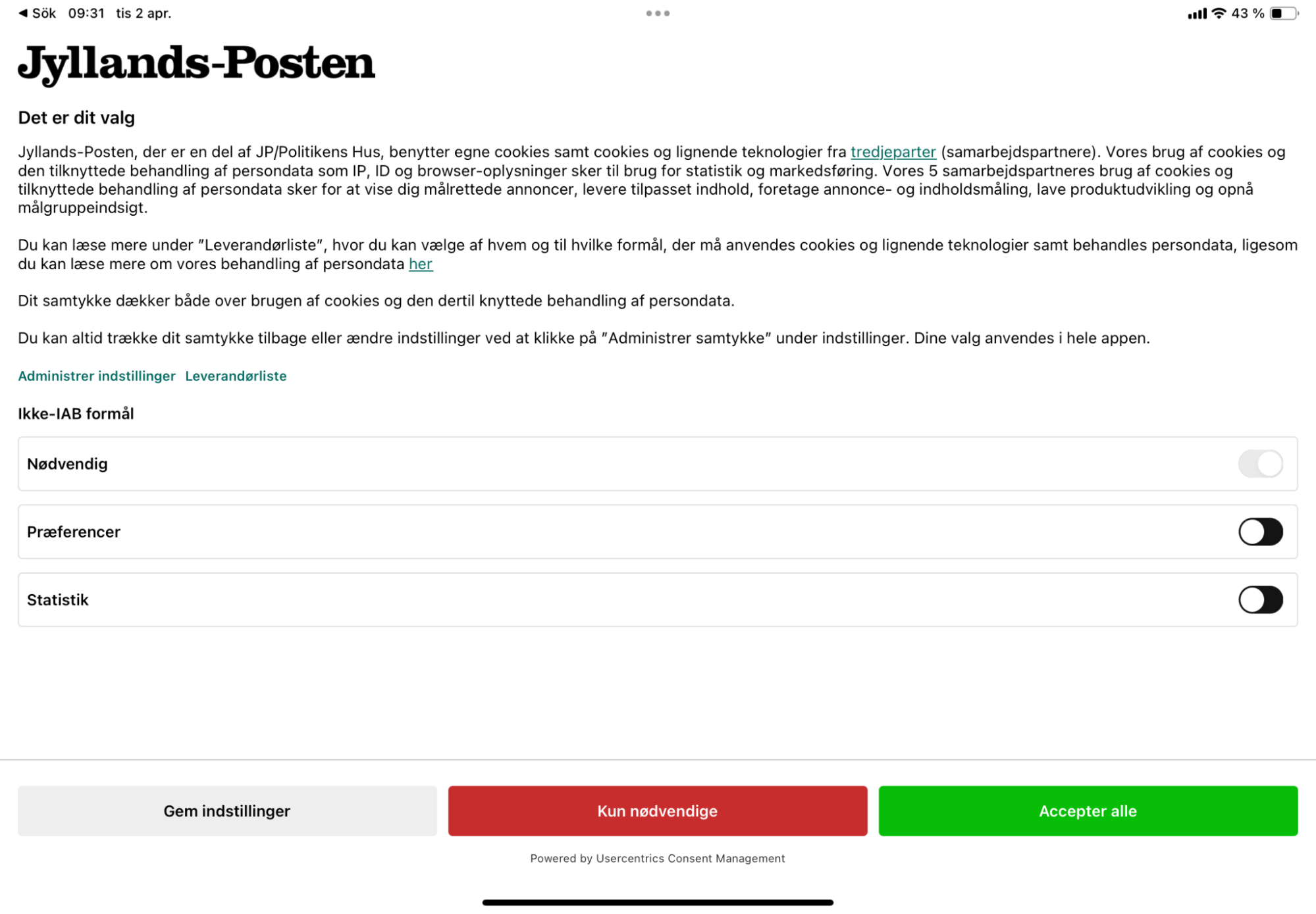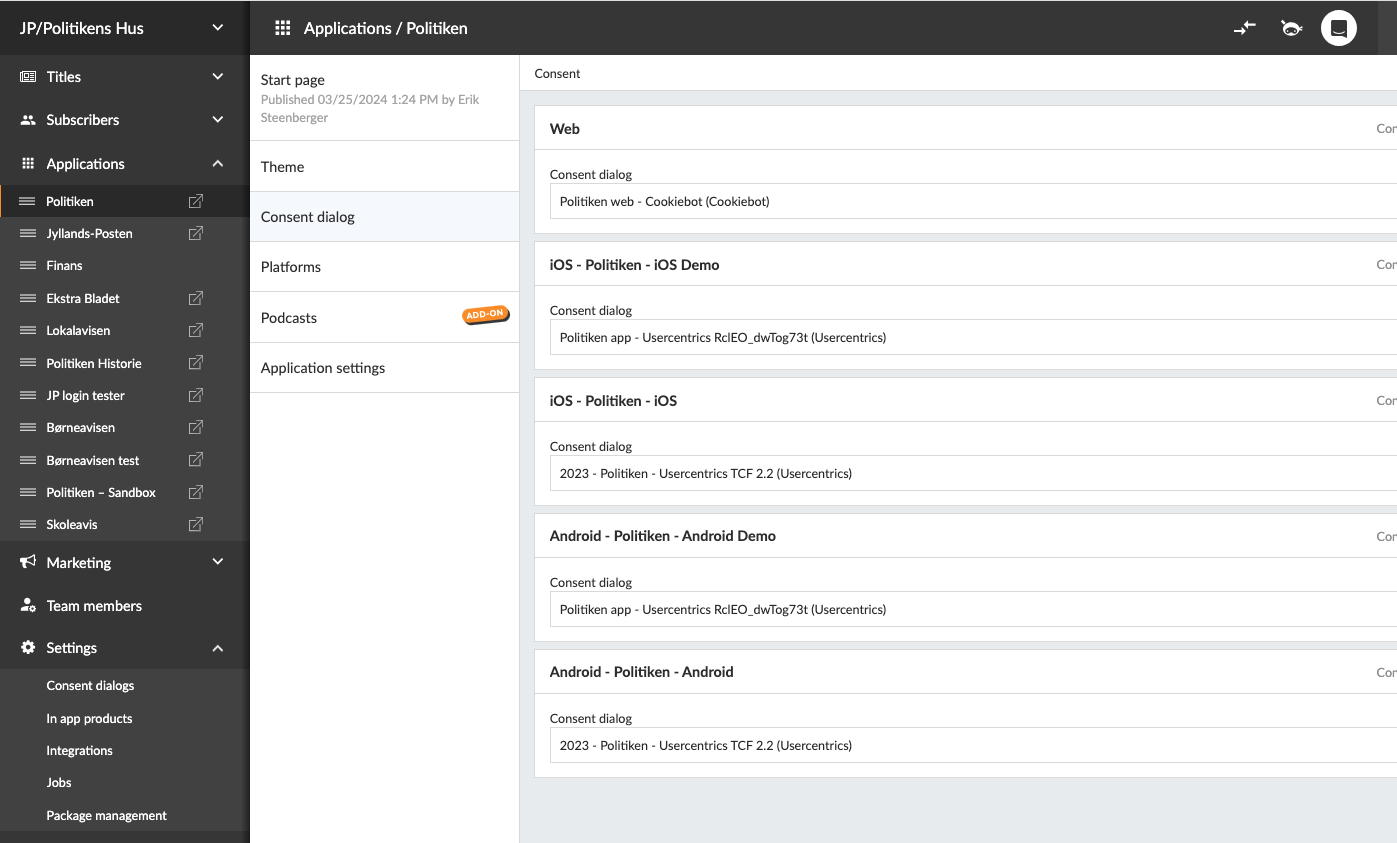Usercentrics - Internal
Art. no. 217060971
What is Usercentrics?
Usercentrics is a third-party consent management platform (CMP) used by JP/Politiken in their IOS and Android apps from 2023.
What is it used for? / What are its functions?
Usercentrics asks users for consent, stores the consent settings and handles the logic for enabling and disabling features.
The Usercentrics dialog is displayed the first time when a user opens the app. It can be reopened from the Settings menu in IOS and Android apps.
Usercentrics in action can be seen in the apps Politiken e-avis, Jyllands-Posten e-avis, Ekstra Bladet e-avis.

Technical details
- We have had access to JP/Politiken’s instance of Usercentrics, but we do not have our own test account.
- The implementation of Usercentrics in IOS and Android is prepared to be used by any customer.
How are custom tabs implemented? - What actions are needed from us?
Add Usercentrics SDK to the apps
SDK should be added when building the apps. Go to Github for reference
Create the consent module in Workspace
Note: From September 2024 the “Usercentrics CMP” module has to be enabled in Superadmin in the application settings, to be selectable in Workspace. In Prenly Workspace click on the Ninja and select Applications. In Prenly Superadmin choose Application → edit; scroll down and click the checkbox for Cookiebot → click save.
- Go to Workspace
- Select customer
- Go to Settings -> Consent
Create New - Choose Usercentrics and name it
Add the necessary information - Save
(Politiken can be used as reference)

Add the consent module to the app clients
- Go to Workspace
- Select customer
- Select applications
- Select application
- Go to Consent dialog
- Select the correct dialog for each client
- Save
(Politiken can be used as reference)

How are custom tabs implemented? - What actions are needed from the customer?
The customer needs an agreement with Usercentrics.
They have to invite us to their Usercentrics admin. (this is not really necessary, but it helps if we need to troubleshoot the integration)
The customer will have to set up the configurations in Usercentrics admin, including the Data Processing services (DPS).
They will have to provide us with the necessary information to connect Usercentrics with Prenly (configuration ID and template IDs).
- The configuration ID is the mapping between Usercentrics and Prenly. The consent notice is created in Usercentrics and a Prenly app must know which consent banner to display, and therefore this ID is used as a connection between Usercentrics and Prenly.
- The Data Processing services (DPS) in Usercentrics are created for each purpose or vendor, so the user can decide whether to give consent for e.g. Statistics, Marketing etc. Normally there are three “categories”: Functional, Analytical and Marketing set up in Usercentrics. Multiple vendors can be added to each purpose category. Google Analytics and Matomo are likely sorted into Analytical, and Youtube into Marketing. This categorization is up to the customer to decide.
- To enable users to control Prenly features from the Usercentrics dialog the DPS “template ids” have to be added to Prenly Workspace. So if a user chooses to not give consent to Analytical -> Google Analytics in the CMP dialog, the Prenly app has to disable this feature for this user. The “template id” defines the mapping between Usercentrics setting and Prenly features.
Related links:
Contact persons
Usercentrics: julius.schulze@usercentrics.com
JP/Politiken: Morten.K.Sorensen@jppol.dk, Helene.F.Saaboll@jppol.dk